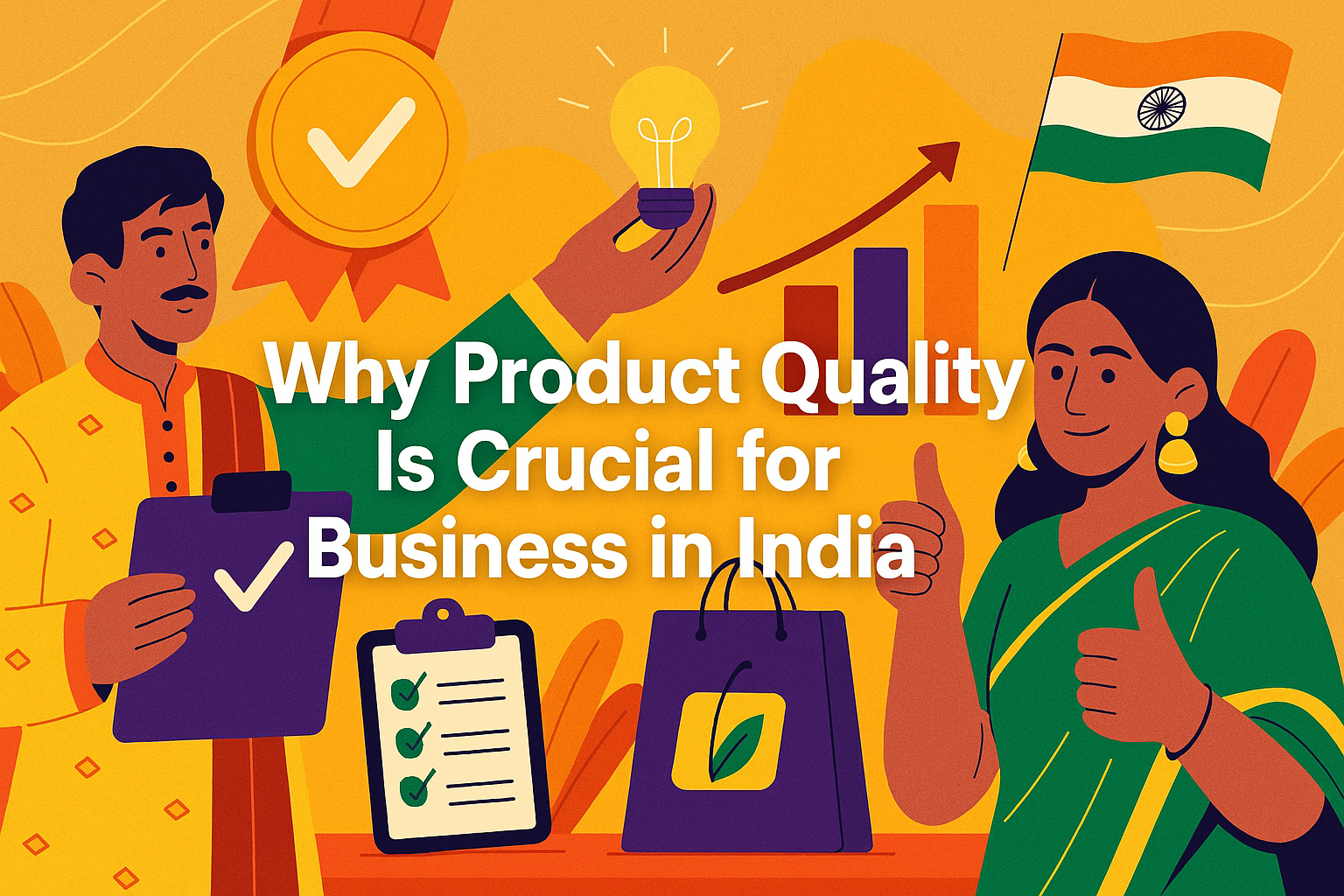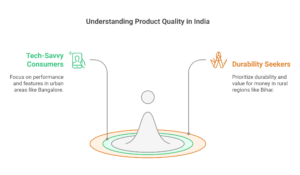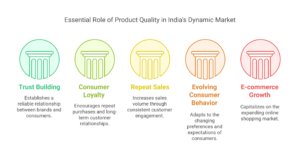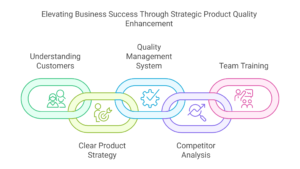
Why Product Quality Is Crucial for Business in India
In today’s competitive Indian market, product quality is more than just a feature — it’s the foundation of customer trust, brand loyalty, and long-term business success. Whether you’re a startup launching a new product or an established company expanding into new regions, quality plays a key role in shaping how your brand is perceived by Indian consumers. With rising awareness, easy access to product reviews, and a growing demand for value-driven purchases, today’s buyers are more informed and selective than ever before.
India’s diverse customer base spans metro cities, small towns, and rural areas — each with its own unique expectations and purchasing behavior. But one thing remains consistent across all regions: consumers expect products that deliver what they promise. Poor quality can lead to bad reviews, returns, and ultimately, loss of reputation — all of which can hurt your business deeply.
This blog will explore why product quality matters, how it influences consumer decisions, and what steps Indian businesses can take to enhance quality and grow sustainably in a crowded marketplace.

What Does “Product Quality” Mean in India?
In India, the meaning of “product quality” goes far beyond just durability or performance — it represents a complete customer experience. With a highly diverse population and a wide range of income groups, the Indian market defines quality through various lenses: reliability, affordability, usability, and even cultural relevance.
For urban consumers in metros like Delhi, Mumbai, or Bangalore, product quality often translates to premium materials, advanced features, user-friendly design, and seamless after-sales service. Meanwhile, in Tier 2 and Tier 3 cities like Indore, Patna, or Kochi, value-for-money plays a significant role. Customers here may associate quality with long-lasting performance, simplicity of use, and a fair price point — especially for essentials like electronics, clothing, kitchen appliances, or daily-use goods.
In India, a product is often judged not just by how well it works, but also by how well it fits into the customer’s lifestyle. Is the packaging eco-friendly? Is the product adapted to Indian usage conditions — like voltage fluctuations, water hardness, or spicy cooking styles? These small but crucial factors can significantly impact how quality is perceived.
Moreover, the rise of e-commerce platforms like Amazon, Flipkart, and Meesho has made Indian buyers even more quality-conscious. Ratings, reviews, and influencer recommendations now play a key role in shaping purchase decisions. Products that fail to meet expectations are quickly exposed, while consistently high-quality items benefit from strong word-of-mouth and repeat business.
Ultimately, in the Indian context, product quality means delivering what you promise — and more. It’s about building trust, adapting to local needs, and offering consistency, whether you’re selling a ₹100 kitchen tool or a ₹50,000 smartphone.

Key Questions to Assess Product Quality:
In the competitive Indian market, simply launching a product is not enough — it must meet high customer expectations across price, performance, and purpose. To ensure your product delivers true value, here are key questions every Indian business should ask when assessing product quality:
1. Does it solve a real problem?
A high-quality product addresses a specific need or pain point. Whether it’s a kitchen appliance, health supplement, or mobile app, it should make your customer’s life easier or better. Indian consumers appreciate practical solutions — your product must offer clear benefits.
2. Is it user-friendly?
Ease of use is essential, especially in a country with diverse literacy levels and tech comfort zones. Can someone in a Tier 2 city or a senior citizen easily understand how to use it? If not, you may need to simplify your design or include multi-language instructions.
3. Is the product durable and reliable?
Indians expect long-lasting products. Whether it’s a pressure cooker, a water purifier, or a mobile charger, it must withstand daily use and Indian environmental conditions like dust, humidity, and voltage fluctuations.
4. Does it meet aesthetic and cultural expectations?
Design matters. Colours, packaging, and even symbols on the product should align with Indian sensibilities. For instance, bright and vibrant packaging often works well in FMCG, while minimalism may appeal to urban, premium buyers.
5. Is the pricing justified?
Affordability doesn’t mean compromising on quality. Indian consumers are value-driven — they want quality that matches the price they pay. Your product should feel like a “smart purchase.”
6. What do customer reviews say?
Online ratings and word-of-mouth are powerful in India. Regularly monitor customer feedback on platforms like Amazon, Flipkart, or Google Reviews to understand where your product excels or needs improvement.
By regularly revisiting these questions, businesses can refine their offerings, build brand loyalty, and stand out in India’s crowded marketplace.
12 Reasons Why Product Quality Matters in India
In a price-sensitive and highly competitive market like India, product quality is more than just a differentiator — it’s a business essential. Indian consumers are becoming increasingly informed, digitally active, and value-driven. While affordability remains a deciding factor, product quality plays a crucial role in building trust, sustaining loyalty, and driving repeat sales.

Here are 12 strong reasons why product quality matters in India, especially in the context of evolving consumer behavior and the growing e-commerce boom:
1. Builds Long-Term Trust
Trust is a critical currency in the Indian market. A high-quality product delivers on its promises, leading to repeat customers and strong word-of-mouth referrals. When a product performs well consistently, it earns the customer’s trust, encouraging them to choose your brand over competitors — even at a higher price point.
2. Reduces Returns and Complaints
Low-quality products are more likely to be returned or generate negative reviews. With platforms like Amazon and Flipkart offering easy return policies, quality-related returns can increase operational costs. For Indian sellers, a high return rate affects seller ratings, rankings, and overall brand perception.
3. Enhances Word-of-Mouth Marketing
In India, family, friends, and peer recommendations still influence buying decisions, both online and offline. When customers are satisfied with the quality, they’re more likely to recommend your product. This organic promotion is more powerful than any paid campaign.
4. Boosts Online Ratings and Reviews
E-commerce platforms are growing rapidly in India. Consumers heavily rely on product reviews and ratings before making a purchase. A consistently high-quality product garners positive reviews, pushing your product higher in search results and increasing conversions.
5. Improves Brand Loyalty
A customer who has a good experience with a product will often stick to the same brand for future purchases. In India, brand loyalty can span generations, especially in categories like home appliances, FMCG, and healthcare. High-quality products nurture loyalty and customer retention.
6. Justifies Premium Pricing
Even in a price-conscious market, Indian consumers are willing to pay more for quality, durability, and safety. A premium product that lasts longer and performs well justifies its price. This opens up the ability to enter mid to high-end market segments without losing competitiveness.
7. Strengthens Your Market Position
In a crowded marketplace, quality can be your biggest competitive advantage. While others compete on price, your brand can lead with trust, performance, and satisfaction. This makes your business less vulnerable to price wars and discount-driven sales strategies.
8. Reduces Warranty Claims and Liability
Poor quality can lead to frequent warranty claims, replacements, or even legal issues — especially in electronics and automobile sectors. Maintaining product standards minimizes risks, improves customer satisfaction, and reduces the burden on your after-sales support team.
9. Aligns with “Make in India” and Export Potential
India’s manufacturing ecosystem is evolving with the Make in India initiative. However, to compete globally and attract foreign buyers, product quality must meet international standards. Domestic success based on quality helps open doors to exports and international partnerships.
10. Supports Sustainable Business Growth
Building a sustainable brand means offering consistent value to consumers. Poor-quality products may sell once, but they rarely win repeat business. High quality leads to customer retention, positive cash flow, and predictable revenue, which are vital for long-term success.
11. Encourages Referrals and Influencer Marketing
From YouTube tech reviewers to Instagram lifestyle influencers, India has a vibrant creator economy. Influencers will only promote products they believe in — and consumers can easily detect dishonesty. Good product quality wins influencer trust, which in turn expands your reach and builds credibility.
12. Elevates Customer Experience Across All Channels
Product quality isn’t just about the item — it’s about the complete experience, including packaging, ease of use, visual appeal, and after-sales service. Whether you’re selling online or in retail stores, customers expect an end-to-end quality journey. A well-made product adds a positive emotional touch that keeps customers coming back.
Final Thoughts
India’s consumers are no longer looking for the cheapest option — they’re seeking value, reliability, and satisfaction. Product quality isn’t just one part of your business; it’s the heart of your brand. Whether you’re a startup, SME, or established business, focusing on quality will help you:
-
Build lasting customer relationships
-
Command better pricing
-
Improve online visibility through positive reviews
-
Lower operational costs via fewer returns and complaints
-
Stay ahead of both local and international competition
If you’re serious about growing your business in India, make product quality your number one priority. It’s an investment that always delivers high returns — financially and in terms of brand equity.
How to Improve Product Quality in the Indian Market: Step-by-Step Guide
India is one of the world’s most diverse and rapidly growing consumer markets. With increasing access to technology, rising incomes, and a growing middle class, Indian customers today expect not just affordability but also high-quality products. Whether you’re a manufacturer, brand owner, or e-commerce seller, product quality is no longer optional — it is the key to long-term business success.

This step-by-step guide outlines practical ways to improve product quality tailored specifically for the Indian market. Whether you’re targeting urban consumers or tier 2/3 cities, this blueprint will help you consistently deliver better value and gain customer loyalty.
Step 1: Understand What Quality Means to Indian Consumers
Before improving product quality, you need to define what “quality” means in your specific market segment. In India, quality can vary by product category and customer demographics. For example:
-
In electronics: Performance, durability, after-sales service.
-
In fashion: Fabric, stitching, comfort, and brand reputation.
-
In FMCG: Taste, freshness, hygiene, and packaging.
-
In toys or baby products: Safety and compliance with standards.
Customer preferences may also differ across regions, so it’s important to do market research — surveys, reviews, competitor benchmarking, etc.
Step 2: Establish Clear Quality Standards
Create well-defined quality benchmarks for your products. These standards should be measurable and trackable. Some key elements include:
-
Raw material specifications
-
Manufacturing tolerances and testing protocols
-
Packaging standards
-
Shelf life and safety norms
For Indian businesses aiming to export, following ISO, BIS, FSSAI, or CE certifications may be required. Certifications not only ensure compliance but also build trust with Indian and international customers.
Step 3: Conduct a Product Quality Audit
Before making improvements, you need a baseline of your current product quality. A product audit helps you:
-
Identify recurring defects or weak points
-
Understand customer pain points from returns or complaints
-
Benchmark against competitors
Hire internal QA experts or third-party auditors to test the product across functionality, durability, safety, and user experience.
Step 4: Source Better Raw Materials
The foundation of a quality product lies in raw materials. Whether it’s electronics components, fabrics, metals, or food ingredients — choosing trusted suppliers is critical.
-
Build strong relationships with local Indian suppliers who maintain high standards
-
If necessary, import specific quality parts that aren’t locally available
-
Set up a supplier evaluation system to regularly assess quality and performance
Step 5: Train Your Workforce
In many Indian manufacturing setups, untrained or semi-skilled labor can be a challenge. Investing in training pays off massively in quality control.
-
Train your workers on quality assurance processes
-
Use visuals, checklists, and SOPs in regional languages if needed
-
Encourage workers to report issues rather than ignore them
-
Incentivize quality performance with recognition or bonuses
This creates a quality-first culture throughout your company.
Step 6: Integrate Quality Checks Throughout Production
Don’t leave quality testing only at the end. Instead, implement quality checks at multiple stages of your production process:
-
Incoming inspection of raw materials
-
In-process quality control (IPQC) during production
-
Final QC checks before packaging and dispatch
Use tools like Six Sigma, 5S, Kaizen, or Statistical Process Control (SPC) if your manufacturing process allows. These methods are increasingly used in Indian industries to drive quality improvements.
Step 7: Gather and Analyze Customer Feedback
Indian customers are active on platforms like Amazon, Flipkart, Google Reviews, and social media. Their feedback is a goldmine for quality insights.
-
Analyze 1-star and 2-star reviews to find recurring complaints
-
Conduct after-sale surveys or follow-up calls
-
Use Net Promoter Score (NPS) to gauge customer satisfaction
Don’t ignore what people are saying about your packaging, delivery experience, or usability — these are key components of perceived product quality.
Step 8: Innovate and Upgrade Product Design
To stay competitive in India’s evolving market, businesses must continually refine product design for performance, aesthetics, and user convenience.
-
Use R&D insights to improve form and function
-
Test prototypes with real users before mass production
-
Adapt products for Indian use-cases (e.g., power fluctuations, hard water, climate)
An upgraded product that solves specific local challenges is more likely to stand out and win customer loyalty.
Step 9: Partner with Reliable Logistics and Packaging Providers
A well-made product can lose its quality during transit or storage. Poor packaging leads to breakage, leakage, or tampering — especially in the Indian climate.
-
Use packaging suited to Indian weather (heat, humidity, rain)
-
Follow tamper-proof and eco-friendly options when possible
-
Choose reliable courier services with good last-mile delivery records
In e-commerce, first impressions matter — ensure the customer receives a clean, well-packed, and intact product.
Step 10: Monitor Return Rates and Product Defect Metrics
Your return rate is a direct indicator of product quality issues. High return rates mean customer dissatisfaction and higher costs.
Set up dashboards to track:
-
% of returns due to defects vs. customer reasons
-
% of products failing quality checks
-
Time taken to resolve quality complaints
Use this data to continuously improve your processes and eliminate root causes of defects.
Step 11: Offer Strong After-Sales Support
After-sales service is a major quality perception factor in India. Especially for electronics, appliances, and healthcare products, quick and effective support builds trust.
-
Set up toll-free customer helplines or WhatsApp support
-
Offer easy-to-access service centers or doorstep repairs
-
Honor warranties and replace defective units with minimal friction
Indian customers are more forgiving of mistakes if the service experience is smooth and respectful.
Step 12: Promote Your Quality Promise
Once you’ve improved your product quality, don’t shy away from marketing it effectively. Use digital platforms, packaging, and branding to emphasize:
-
Certifications (BIS, ISO, Organic, Vegan, etc.)
-
Quality assurance practices
-
Product performance and safety features
-
Customer satisfaction stats
This helps consumers make informed and confident buying decisions, especially online.
Final Thoughts
Improving product quality in the Indian market isn’t a one-time task — it’s a continuous commitment. From sourcing better materials and upgrading design to training workers and offering great after-sales support, every touchpoint matters.
In a country where consumers are increasingly brand-conscious, digitally connected, and review-savvy, product quality is your biggest competitive advantage. It not only increases customer retention but also enables you to scale across regions, expand your product lines, and even explore international markets.
Whether you’re a startup or an established business, adopting a step-by-step, customer-centric quality strategy is the surest way to stand out in India’s dynamic marketplace.
Conclusion
In the competitive and diverse landscape of the Indian market, product quality is no longer a luxury—it is a necessity. Today’s Indian consumers are informed, value-conscious, and have access to countless alternatives. Delivering consistent quality helps businesses build trust, encourage repeat purchases, and stand out in a crowded marketplace. Whether you are a local brand or an international company entering India, focusing on product quality is the key to long-term success.
Improving product quality involves more than just better materials; it includes understanding consumer expectations, refining production processes, training your workforce, and providing excellent after-sales service. Every step of the customer journey reflects your brand’s commitment to excellence.
In a market as fast-paced and evolving as India’s, businesses that prioritize quality are more likely to gain customer loyalty and sustainable growth. By taking a strategic, step-by-step approach to quality improvement, you not only meet market demands but also future-proof your business in one of the world’s most promising economies.

